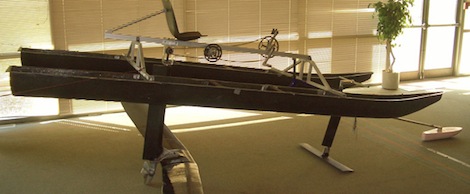
Hackaday regular [Berto] is always looking for new ways to get around, and wrote in to share his most recent creation, an amphibious bicycle.
He bought an off-the-shelf inflatable boat and constructed a rig that allows him to stably mount the bike on it. Once [Berto] comes across a body of water he wants to cross, all he requires is about 7 minutes time to inflate the boat and attach his bike. Using a modified version of his electric drill-based trolling motor we saw last year, the Amphi-cycle glides across the water effortlessly as demonstrated by his assistant in the video below.
Right now the boat is propelled solely by the trolling motor and a large lead-acid battery. We would love to see the amphi-cycle powered by its rider, though we don’t know how that would affect the “one boat fits all” design [Berto] is aiming for.










Recent Comments